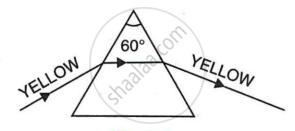Advertisements
Advertisements
प्रश्न
उत्तर
Three properties of infrared radiations similar to the visible light:
1. They travel in straight lines as light does, with a speed equal to 3 x 108 m/s in vacuum.
2. They obey laws of reflection and refraction.
3. They are unaffected by electric and magnetic fields.
Two properties of infrared radiation different from the visible light:
1. They are absorbed by glass, but they are not absorbed by rock-salt.
2. They are detected by their heating property using a thermopile or a blackened bulb thermometer.
APPEARS IN
संबंधित प्रश्न
A student is observing a diagram showing the path of a ray of light passing through a glass prism. He would find that for all angles of incidence the ray of light bends:
Why do the component colours of incident white light split into a spectrum while passing through a glass prism, explain
What acts as tiny prisms in the formation of a rainbow?
The diagram below shows the path taken by a narrow beam of yellow monochromatic light passing through an equiangular glass prism. If the yellow light is replaced by a narrow beam of white light incident at the same angle, draw another diagram to show the passage of white light through the prism and label it to show the effect of prism on the white light.

A glass prism is able to produce the spectrum when white light passes through it, but a glass slab doesn’t produce any spectrum. Explain why it is so.
The wavelengths of violet and red light are 4000 Å and 8000 Å respectively. Which of the two has the higher frequency?
Write the range of wavelength of the infrared spectrum.
What is dispersion? Explain in detail.
The splitting of white light into its component colours is called ____________.
